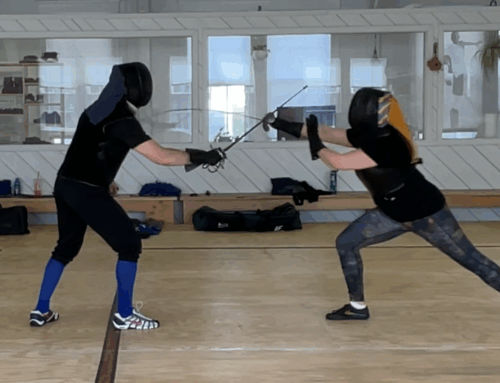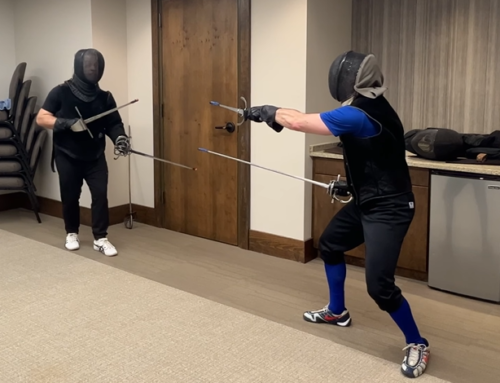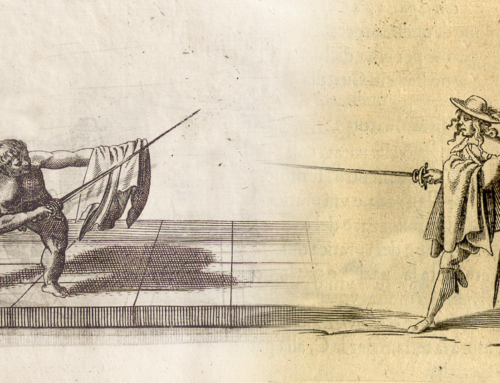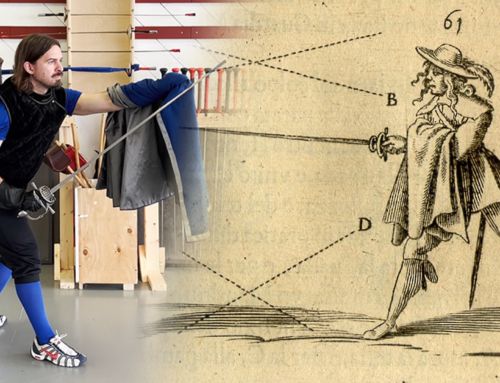We just ended a training block on defense at Boston Academie d’Armes, the second half of the block looking at counterattacks.
There are many counterattacks in our system, but here are the ones we focused on last month:
- Arrest with Reassemblement. Used against attacks to the leg.
- Time-thrust. A thrust along the same line as the opponent’s attack, striking and shutting out the line at the same time. Sometimes called a “single-tempi parry-riposte.”
- Passata Sotto. Used against attacks to the high-outside line by voiding the body below the opponent’s attack.
- Intagliata. Used against attacks to the high-outside line by stepping crossline, across the line of direction to one’s inside.
- Girata & Inquartata. Used against attacks to the inside line by voiding the offside shoulder and stepping offline with either the front or back foot.
For this blog post (and video), I want to look at the passata sotto, a counterattack in which the fencer lowers their body below the opponent’s attack.
Traditionally, it’s used against attacks to a fencer’s high-outside line but can be done against attacks to the high-inside line (with care) or after a fencer’s own feint (also with care). It’s use and application varied and changed over the years and between masters. So I do highly recommend folks pick up the translations if you can to see all the action’s use.
In this blog/video, we’ll look at six variations of the passata sotto that were popular in rapier, smallsword/dueling sword, and foil — though they could be utilized, really, with any single-handed weapon.
Special shoutout to Maestro Charles Dobbs. He’s a prolific researcher into historical and classical fencing, a fantastic coach, and all-around nice guy. He was kind enough to share a 112-slide presentation with various passata sotto variations from the 17th through 21st centuries; I learned a new one from it.
A Rose by Any Other Name…
The passata sotto has gone by many monikers over the centuries including:
- catoccio
- sbasso
- sottobotta
- the night-thrust
- une passe dessous
- botte 2nd
- lunge with the body low
- under stop-thrust
- and probably many others…
The name doesn’t super matter here. The objective is always the same: get below the opponent’s sword so you pass underneath it and strike in the tempo of their attack (or sometimes defense).
All variations in the video show the passata sotto as a counterattack against an opponent’s attack to the high-outside line. However, some masters use it after feinting, etc. It’s worth picking up the sources to find the full variety of the passata sotto’s use.
General Notes on the Passata Sotto
Few important items when executing the passata sotto:
- Getting under the opponent’s attack is key. Since there’s no real opposition, you need to evade the attack completely.
- The higher the attack, the easier it is to counter with the passata sotto. Trying to void beneath an attack aimed at your belly would be very difficult (albeit very impressive, too).
- Keep your head below the hilt of your sword. You may not get opposition, but a high hilt can offer some passive protection.
- I usually perform passata sottos with my hand in first position (knuckles up) or second position (palm down).
- If you can help it, don’t hang out in the posture. Again, there’s no real opposition so you are exposed to getting hit. Land the shot and recover out (forward or backward).
- Judge bouts may make this difficult if you recover too fast, unfortunately. Judges may miss the shot, so make adjustments as you need for the environment you’re fencing in.
6 Passata Sotto Variations for Rapier, Smallsword, Foil & Beyond!
Passata Sotto Variation #1: The Low Pass
SOURCE: Salvator Fabris (1606)


We’ll start off with my favorite variation, which comes straight from Salvator Fabris (1606).
Think of this one as a passing attack in which you carry your body low and underneath the opponent’s blade.
How to Perform:
- Fold your body diagonally toward your inside line (your left if you’re a righty) and shift your weight onto your lead leg.
- Extend your sword arm while doing this.
- Use your butt for counterbalance.
- Once you get as low as you comfortably can, you bring your rear foot to the front.
- After striking, continue moving forward.
I like to teach my folks to “high-5” the opponent’s hilt as they pass by to keep their opponent from a late afterblow.
This is an all-around good variation. It’s especially nice if you have shorter reach than your opponent, as it’ll let you cover more distance while counterattacking.
The Passata Sotto Limbo is a fun game for training folks this particular action and can be done as a group or a solo drill.
Passata Sotto Variation #2: Low Lean
SOURCE: Nicoletto Giganti (1606) & Francesco Alfieri (1640)


Next up is a relatively easy variation found in both Giganti and Alfieri.
It’s performed simply by leaning toward your inside line, getting beneath the opponent’s attack.
You use your butt as counterbalance to keep from falling over.
Your opponent does need to be pretty close to perform this exactly as the illustration shows, so this is a good option if your opponent sets up real close, is charging forward, or has shorter reach than you.
Passata Sotto Variation #3: The Classical Passata Sotto
SOURCE: Giuseppe Morsicato Pallavicini (1670), Francesco Marcelli (1686), Rosaroll & Grisetti (1803), and so many, many more…


Next up is what most folks probably are thinking of when they hear the phrase “passata sotto.”
This is perhaps the most commonly found variation among fencing books, especially those rooted in the Italian tradition.
It’s performed by doing a “reverse lunge.” As the attack comes, you kick your back leg out and drop your chest toward your thigh as low as you can go.
The offhand should be there for counterbalance or as backup if you start to fall over. I high recommend not slamming your hand into the ground, as you could injure your wrist.
You could also do this by lunging forward, too, instead if you needed cover more distance, especially in rapier where the reach discrepancies can be much larger than other weapons.
Passata Sotto Variation #4: Low Lunge or Low Intagliata
SOURCE: Giuseppe Ridolfo Capoferro (1610), Charles Besnard (1653)


This is similar to the classical passata sotto above but is done as a low, forward lunge… so like your normal lunge but carrying the body lower and beneath the opponent’s offense or defense.
This can be done on the line of direction or slightly crossline toward your inside line. In the video, I show this as a crossline low lunge (so like the intagliata but lower), mostly as a way of showing an offline lunge variation, but it can be done straight.
In the image demo above, I’m stepping pretty far to my inside line; you don’t need to step nearly as far.
Passata Sotto Variation #5: The “Old Man”
SOURCE: Vittorio Lambertini (1870)


This is a variation I had never seen before and comes from Vittorio Lambertini (1870). The Radaellian Scholar as a blog post on Lambertini, including a PDF scan of his manual and a transcription.
He shows both a more traditional passata sotto and this version where the back hand is resting on the lead led. Because of how this second version looks, I’ve dubbed it the “Old Man Bracing” version.
Lambertini doesn’t provide a difference of use, just saying the passata sotto has the offhand on the ground or on the lead thigh.
Passata Sotto Variation #6: The Duck or “Slavic Squat” Sotto
SOURCE: All’Esposizione di Parigi (1889) and contemporary fencing


The last variation we looked at is more popular in modern sport fencing but it does appear in artwork from All’Esposizione di Parigi (1889) — a famous fencing exhibition in Paris during 1889.
This variation just calls for the fencer to duck underneath the attack, by squatting down as low as one can.
Beyond needing to do a squat, it’s not a highly technical action but is very quick and perhaps the easiest to learn of the bunch.
This blog post from Armi da Sala has a little series on the artwork and exhibition.
Other Variations…
This blog and video isn’t an exhaustive list of passata sotto variations, just of ones I like and prefer my students work from.
Other versions of the passata sotto including dropping to a knee while voiding the attack, as well as a “turning passata sotto” which I can only describe as a passata sotto and a girata had a baby. It’s very theatrical, so has the cool factor, but is not as effective as these other versions and doesn’t seem to appear until the 20th century (though if it appears earlier, let me know!).








